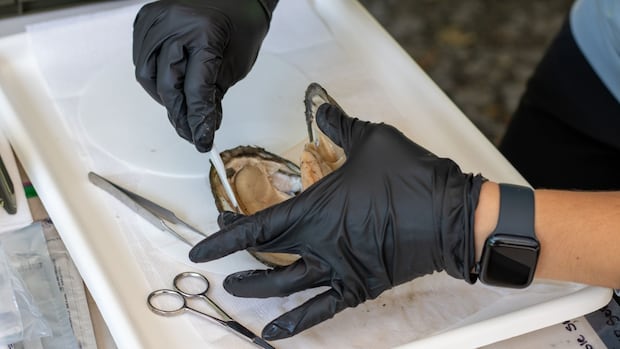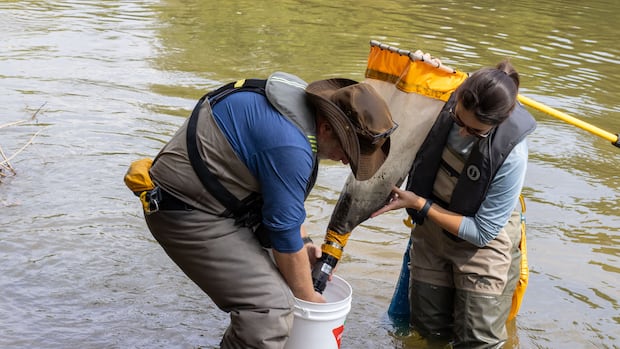By studying mussels in the Grand River in Brantford, Ont., a team of scientists hopes to better understand how some chemicals are affecting the environment.
Patty Gillis, a research scientist with Environment and Climate Change Canada, studies aquatic contaminants with her team based at the Canada Centre for Inland Waters in Burlington, Ont.
She and her team use native freshwater mussels as “messengers of the water quality” to answer questions about the distribution and effects of contaminants.
Mussels don’t move around much. They bury themselves in sediment and filter water through their gills, meaning they’re exposed to contaminants from the water and riverbed.
“Maybe they’ve been exposed to something like a metal or a pharmaceutical in the river that makes them not be as healthy. So, we can quantify some of those by taking a piece of their tissue,” Gillis said.
Environment and Climate Change Canada research scientist Patty Gillis explains how her team is using mussels to learn about the effect of chemicals in the Grand River near Brantford, Ont.
Her team is sampling at the river, downstream of the municipality’s wastewater treatment plan. They’re hoping to understand how individual chemicals and mixtures of chemicals affect different mussel species by studying their population, analyzing stresses the mollusks are under and testing their bodies for metals and chemicals.
Other teams are doing similar work by looking at other species, such as snails, birds and fish. The overall initiative is a pilot project called the Integrated Chemical Mixtures Project (ICMP), which is studying sites in Brantford and Windsor, Ont.

Project part of wider effort to understand impact of chemical contaminants
Burlington chemist Mark Hewitt is a coordinator on the ICMP project. Hewitt, who researches complex chemical mixtures, says they’re “something Canadians need to know about.” His team uses the analogy of an iceberg to describe complex mixtures, and how relatively little is known about them.
“This project is seeking to understand the total iceberg with a focus on the unknown parts,” he said, adding it “forges a path for us to identify solutions to harmful effects if we find them.”
The project began after the federal government recognized a right to a healthy environment, Hewitt said, and uses a team approach to best understand impacts on human health and the environment.
If, for example, Gillis’s team finds a high chemical concentration in mussels’ tissue, those results can be compared to other ICMP teams’ findings to learn how wide-ranging it is.
In Sarnia, Hewitt said, researchers are able to assess impacts near heavy industry. Brantford is fairly representative of other Canadian municipalities, he said, since there’s a municipal wastewater centre and it’s near agricultural regions.

On Sept. 23, CBC Hamilton had a look at the project in Brantford, where Gillis and her team set up their mobile lab in a parking lot at a hiking path near Mohawk Street and Beach Road.
While co-op student Harmony Ho and senior technologist Jim Bennett measured mussels and recorded their sizes, physical scientist Erika Burton drew hemolymph, which is like blood, from specimens.
Burton would then freeze the samples in a container of dry ice and pass the mussel on to technologist Lisa Hoard, who began dissecting it.

The captured mussels clammed up, so the researchers had to put their backs into the work, carefully forcing the mussels’ shells apart.
Gillis said the specimens sacrificed are studied by multiple teams. They measure the animal’s stress by analyzing its hemolymph and gills. The rest of the soft tissue is mashed up and sent to chemists who determine what contaminants have accumulated in the animal.
Research scientist Patty Gillis and her team are studying mussels in the Grand River near Brantford, Ont. As part of their work, they’re also assessing the broader environment. They demonstrate one way they collect samples of the river bed to learn what creatures live there.
The team is also studying the environment they’re working in, including by measuring the flow of the river, the acidity of the water and analyzing samples from the river bed to learn which invertebrates live there.
Next year, Gillis plans to place mussels in the water upstream and downstream of the wastewater plant, and an industrial area where gypsum — the main ingredient for drywall and plaster — is produced, so her team can learn how quickly the animals are stressed and how chemicals accumulate. At the same time, other scientists will conduct similar experiments on fish, shrimp and snails.
“Different critters respond differently to chemicals,” Gillis said. “[Maybe] the mussels aren’t very happy here, but what if all the rest of the critters are? We want the broader picture.”
“We’re in the information-gathering stage and then when we find effects, we will keep going and try to figure out what’s causing them,” she added. “Then hopefully we’ll do that at other places in Canada, too.”








